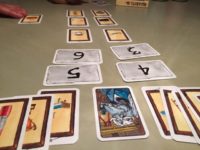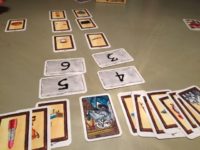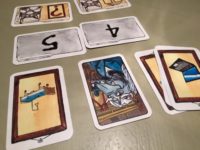- Learning time
- 10 minutes
- First play time
- 60 minutes
Belratti
Designed by: Michael Loth
Belratti is a co-operative game where everybody is trying to prevent dastardly forger Belratti from getting his fakes into the museum. Players divide into a team of painters who’ll submit their artworks, and a team of museum curators who’ll try and separate the real submissions from Belratti’s infiltrated efforts…
Everyone is dealt nine painting cards from the huge deck. Two more painting cards are flipped over showing the themes the museum is commissioning for, and the museum team tell the painters how many paintings they’d like to exhibit this round (between 2 and 6). The painters look through their cards to see if they have paintings that might possibly come under the umbrella of either theme, and converse with each other as to how many they have – and how confident they feel about them. They cannot show each other their paintings, however, or discuss what any painting is of!
Once they’ve concluded which paintings to submit, they are are handed face-down to the museum team. Now 4 more cards from the deck get shuffled in too, representing Belratti’s paintings. The museum team then look at all the paintings and decide which ones were submitted by the players. At this point the painting team must be completely poker-faced! …Or at least disciplined enough not to drop any clues. Once the museum team have decided which paintings go with which theme, the painters can tell them what they got wrong or right.
A player’s painting assigned to the correct theme – that’s a point for all the players!
A player’s painting assigned to the wrong theme – is discarded.
A Belratti painting assigned to either theme – is a point for Belratti!
A new round begins with the museum and painting team members moving clockwise around the table so roles keep changing. Once Belratti has snuck six fakes into the museum, the game ends and players win if they have at least fifteen of their own paintings into the museum at this point. But there are degrees of success and failure (30 paintings being the holy grail and none at all being utter disaster) so there’s always a challenge to outdo previous scores…
Finally there are four extra cards that can be utilised by the teams, to change themes, swap cards, or change the targeted number of paintings for a particular round. The catch is that when used, they are flipped face-down and only completing a ‘perfect round’ can flip them over again.
Joe says
I didn't have high hopes for Belratti, but it turns out it's a brilliant little team deduction game that reminds me a lot of Mysterium, without any of the teaching overhead and fiddly set-up of that game. Very clever, and more importantly, fun!
The guru's verdict
-
Take That!
Take That!
None
-
Fidget Factor!
Fidget Factor!
The museum team will have to be patient while the painters decide what to do, and vice versa. But neither should take forever and as a painter, watching the museum team is loaded with tension...
-
Brain Burn!
Brain Burn!
The only burning here is looking for visual, thematic, or lateral links. The rules are very very light.
-
Again Again!
Again Again!
Almost infinite replayability due to the fact the players' interpretative variance has so much bearing on proceedings.








Sam says
An unassuming package with a miniature classic inside: Belratti takes the genius of clue-giving in Codenames or GNG favourite Decrypto and aligns it closer to the pace of the lighter, faster-moving Just One, a simple party game where everyone works together for a common cause, but are unable to share crucial information. All of those games allow a lot of creative player input, and although your choices are limited to the nine cards, there's a sense of of that here too: when you're a painter, the museum team (who are on your side, remember) know that choices might be limited and have to bear that in mind. Sometimes it's enough and you sneak every painting through - sometimes Belratti strikes gold and turns up fish to go with chips, or something equally nailed-on. So there's an element of luck in your success, or lack of it, but not enough to stop this from being a really fun game.